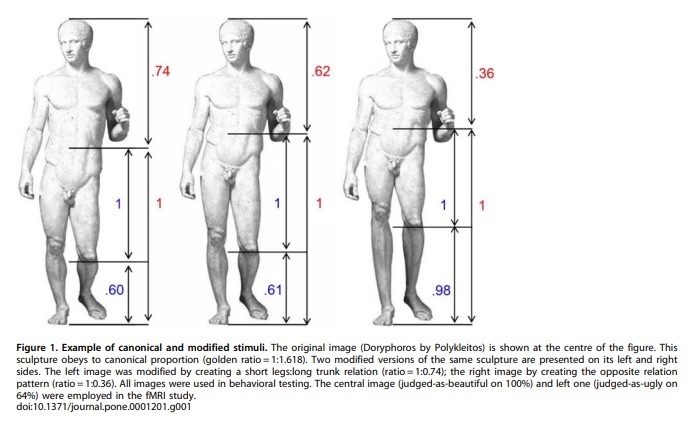



The German team had chosen symmetry; the Italians preferred the golden ratio. Both symmetry and the golden ratio have for centuries figured prominently in empirical and philosophical inquiries into art and aesthetic experience; the fact that the debate about their role and status still goes on suggests the extent to which they do not represent merely factual matters but are dense condensations of values and worldviews.
The Italian team used fifteen sets of three images, each including fifteen originals and fifteen modified pictures (seven with long trunks and short legs, eight with short trunks and long legs); twenty sculptures represented male bodies and ten, female bodies. The stimuli, thirty for each of six separate fMRI runs, were presented, in a randomized order and for two seconds each, in three conditions: observation, in which subjects were asked “to observe the sculptures as if they were in a museum,” aesthetic judgment (subjects were asked if they liked the image), and proportion judgment (whether they found the image proportionate).
The behavioral results showed that canonical images were evaluated more positively and modified ones more negatively. In MRI analysis, the results of viewing canonical and modified conditions were first taken together and then contrasted with the rest across all three conditions (observation, aesthetic judgment, and proportion judgment). This contrast revealed “activations” in several areas. Especially significant for the authors was signal enhancement in the insula during the observation condition. The insula is one of the most beloved brain structures of the neuro industry. It is involved in motor control and homeostasis, as well as in interoception and visceral states associated with emotional experience, in addition to self-awareness and sense of agency.
The authors acknowledge that it would be “too reductive” to imagine that the sense of beauty “occurs because” of insula activation; joint activation of many areas and circuits is needed. In sum, could artworks “ever become a permanent patrimony of humankind without a resonance induced by some biologically inherent parameters?” (8). The answer is obviously “no.”

Example of the images used in the study, taken from the article by Di Dio, Macaluso and Rizzolatti (...

Finally, you can also buy The Golden Ratio: The Story of Phi, the Extraordinary Number of Nature, Art and Beauty, by Mario Livio, a book cited by Di Dio et al.:

Inspired by the homonymous book by Fernando Vidal and Francisco Ortega, this timespace presents the authors' genealogy of the cerebral subject and the influence of the neurological discourse in human sciences, mental health and culture.